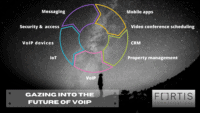Omnichannel experiences have revolutionized the way enterprises communicate with their customers. Rather than limiting communication to a single channel, such as email or phone, omnichannel experiences allow enterprises to communicate with customers through multiple channels, including social media, SMS, chat, and more.
By leveraging omnichannel experiences, enterprises can level up their communication in a number of ways:
- Personalization: Omnichannel experiences enable enterprises to tailor their communication to individual customers, based on their preferences and behaviors. By gathering data from various channels, enterprises can create a more personalized and targeted experience that resonates with their customers.
- Consistency: Omnichannel experiences ensure that communication is consistent across all channels, creating a seamless experience for customers. This can help build trust and loyalty, as customers feel confident that they will receive the same level of service and communication, regardless of the channel they choose to use.
- Accessibility: Omnichannel experiences make communication more accessible for customers, as they can choose the channel that is most convenient for them. This can lead to increased engagement and satisfaction, as customers feel empowered to communicate on their own terms.
- Efficiency: Omnichannel experiences can increase the efficiency of communication for enterprises, as they can manage multiple channels through a single platform. This can streamline workflows and reduce the risk of communication breakdowns or delays.
Overall, omnichannel experiences have the potential to level up communication for enterprises by creating a more personalized, consistent, accessible, and efficient experience for customers. By leveraging the power of multiple channels, enterprises can build stronger relationships with customers and differentiate themselves in a crowded marketplace.

What is omnichannel communication?
Today’s customer journeys span back and forth between digital and physical touchpoints, weaving from one platform and one device to another as they evaluate their options and decide whom to do business with. If you want to reach them, you must be present where they are and use the channels they use – WhatsApp, Facebook, Instagram, SMS, Email etc.
At its core, omnichannel marketing is about removing any friction points or barriers to entry and communicating with your customers on channels they already prefer. It is an integrated approach to marketing that puts the customer first and builds a series of sales and marketing strategies around it.
Why does omnichannel work better than traditional communication strategies?
Omnichannel experiences have several advantages over single or multi-channel strategies because they more accurately account for the complexities in today’s buying journeys. It allows brands to follow potential customers from the consideration to the post-purchase phase and beyond. With omnichannel communication, you can create a holistic customer experience that is enriched with each time customers visit one of your touch points, whether it’s your website or a brick-and-mortar store.
More seamless buying journeys
Since an omnichannel strategy is built with the customer as the focus, it gives brands more room to account for individual customer preferences. When you put yourself in the customer’s shoes and simulate interactions with your brand, you can quickly spot potential friction points and eliminate them to provide a smoother buying experience.
With an increased understanding of what makes potential buyers bounce, you can design funnels that specifically address drop-off points. Using modern MarTech, you can build visual customer journeys and split-test campaigns to refine and hone them.
With an omnichannel communication approach, your online and offline presences can become cohesive, consistent and build upon each other. For example, you can deploy AI-powered virtual shopping assistants that can guide customers through the buying process, suggesting options and answering questions as and when needed. You can use customer profiles to offer exclusive discounts in-store. Sales representatives at your physical stores can use data that you have gathered about customers to gauge their preferences and offer them a more customized buying experience.
Customers stay around longer
Studies from Google have shown that omnichannel buyers have a higher LTV than customers who only use one channel. With an omnichannel strategy, you have many avenues to nurture your customer relationships beyond the initial purchase. When people are constantly engaging with your brand’s content, they are more likely to buy from you.
A higher degree of customer service
With more channels for your customers to reach out to you on, there are more ways for your brand to gain valuable feedback. Additionally, with the use of automation and AI/ML technologies like chatbots for your website/WhatsApp/Facebook messenger, you can have a 24/7, always-online customer service presence.
With an omnichannel approach, you will have a lot more context about your customers and learn more about their preferences which you can use to adapt your marketing on the fly.
Improving conversions
With an omnichannel strategy, you won’t lose touch with prospects who don’t make a purchase within a single interaction. Let’s say someone comes to your website and adds an item to their cart but don’t complete the purchase. After they bounce off your page, you still have a multitude of channels to reach out to them and incentivize them to complete the transaction.
In this particular example, you can send them a cart abandonment reminder email that lists the products they added to cart but didn’t check out. Within this email, you can offer them a slight discount or free shipping to nudge them to complete their purchase. Similarly, you can send them a WhatsApp message with an exclusive or time-bound discount that will encourage them to finish buying.
Cart abandonment is something all online businesses struggle with, and the effectiveness of an omnichannel approach in combating this problem is reason enough for any brand to consider adopting it.
Brands can also use other discount types and run loyalty/ rewards programs to keep customers excited about doing business with them.
Omnichannel communication is a win-win proposition for both your brand and your customers. But before you embark on an omnichannel strategy, make sure you involve all of the stakeholders within your organization to ensure that the different teams are in sync and working towards a coherent goal.
Sources: https://www.tanla.com/





